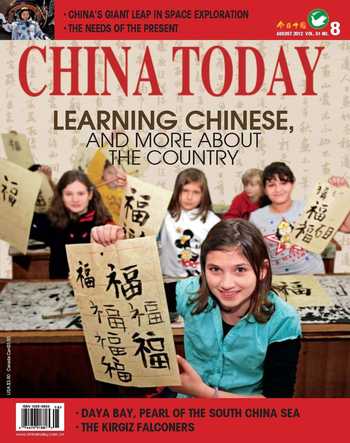Lotus Painter Cai Qibao
ZENG PING
THE studio is small and cramped. One has to edge ones way along it to avoid knocking over the tools of his trade – brushes, sticks of ink, paper, inkstones, and stamps – and a pile of letters on his work table. Cai Qibao jokes that his studio is possibly the smallest in Beijing.
Looking down on Zhongguancun South, a busy street in downtown Beijing, from an old office building, Cais two-room studio feels cocooned from the citys hectic life. The other room holds a tea table, where Cai offers guests a cup of tea or a shot of wine before giving them a demonstration of how he paints. In the tearoom, a horizontally placed work of calligraphy announces the name of Cais workplace, “Jing Feng Ge” or Peaceful Wind Studio.
On the walls are paintings and works of calligraphy, including a portrait of Cai Xiang(1012-1067) in court costume. Cai was a prominent calligraphy master and senior official during the Northern Song Dynasty, and Cai Qibao is his direct descendant. The 44-year-old artist is a council member of the Traditional Chinese Painters Association.
Cais particular focus is on ink and wash paintings of lotuses. In traditional Chinese culture, the lotus flower symbolizes a lofty heart and mind and peace, harmony and happiness. Zhou Dunyi (1017-1073), a Chinese philosopher and the father of Neo-Confucianism, famously wrote the Ode to Lotus, saying the flow grows out of the dirty mud yet is chaste, beauteous but in no way frivolous. Since he wrote this essay expressing his love for the lotus flower, the plant has been compared to a man of great virtue.
The lotus is an important symbol in Buddhism, based on preceding Indian culture and customs, from its very beginning. Lotus patterns are ubiquitous in regions inhabited by Buddhists and can be seen everywhere in Buddhist architecture, including temples and pagodas. In China the many incarnations of Avalokitesvara, or Goddess of Mercy, often appear sitting or standing on a lotus pedestal, holding a lotus flower in hand or reclining amid lotus blossoms.
To capture the essence of this sacred flower with his brush, Cai Qibao has immersed himself in them, studying Buddhist texts on lotuses and poems and essays singing their praise. His dedication has led him to travel to many lakes and ponds to observe these distinctive flowers, and he has a dream to visit all the lotus ponds around the country so he can capture their spirit more accurately.
He has also been inspired by postmodernism, bringing certain elements into his Chinese ink and wash paintings and creating a style that combines both tradition and modernity that allows him to express contemporary thoughts and ideas on this time-honored subject matter.
“I have devoted all my soul to combining the techniques of Chinese calligraphy and the elements of Chinese ink and wash painting in my lotus painting and I believe what I am doing is appreciated by kindred spirits who love the lotus,”Cai said.

